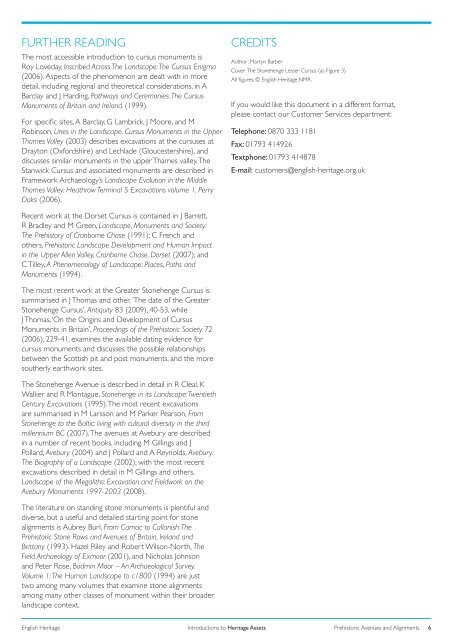Prehistoric Avenues and Alignments - English Heritage
Prehistoric Avenues and Alignments - English Heritage
Prehistoric Avenues and Alignments - English Heritage
You also want an ePaper? Increase the reach of your titles
YUMPU automatically turns print PDFs into web optimized ePapers that Google loves.
FURTHER READING<br />
The most accessible introduction to cursus monuments is<br />
Roy Loveday, Inscribed Across The L<strong>and</strong>scape: The Cursus Enigma<br />
(2006). Aspects of the phenomenon are dealt with in more<br />
detail, including regional <strong>and</strong> theoretical considerations, in A<br />
Barclay <strong>and</strong> J Harding, Pathways <strong>and</strong> Ceremonies. The Cursus<br />
Monuments of Britain <strong>and</strong> Irel<strong>and</strong>. (1999).<br />
For specific sites, A Barclay, G Lambrick, J Moore, <strong>and</strong> M<br />
Robinson, Lines in the L<strong>and</strong>scape. Cursus Monuments in the Upper<br />
Thames Valley (2003) describes excavations at the cursuses at<br />
Drayton (Oxfordshire) <strong>and</strong> Lechlade (Gloucestershire), <strong>and</strong><br />
discusses similar monuments in the upper Thames valley. The<br />
Stanwick Cursus <strong>and</strong> associated monuments are described in<br />
Framework Archaeology’s L<strong>and</strong>scape Evolution in the Middle<br />
Thames Valley: Heathrow Terminal 5 Excavations volume 1, Perry<br />
Oaks (2006).<br />
CREDITS<br />
Author: Martyn Barber<br />
Cover: The Stonehenge Lesser Cursus (as Figure 3)<br />
All figures: © <strong>English</strong> <strong>Heritage</strong>.NMR.<br />
If you would like this document in a different format,<br />
please contact our Customer Services department:<br />
Telephone: 0870 333 1181<br />
Fax: 01793 414926<br />
Textphone: 01793 414878<br />
E-mail: customers@english-heritage.org.uk<br />
Recent work at the Dorset Cursus is contained in J Barrett,<br />
R Bradley <strong>and</strong> M Green, L<strong>and</strong>scape, Monuments <strong>and</strong> Society:<br />
The Prehistory of Cranborne Chase (1991); C French <strong>and</strong><br />
others, <strong>Prehistoric</strong> L<strong>and</strong>scape Development <strong>and</strong> Human Impact<br />
in the Upper Allen Valley, Cranborne Chase, Dorset (2007); <strong>and</strong><br />
C Tilley, A Phenomenology of L<strong>and</strong>scape: Places, Paths <strong>and</strong><br />
Monuments (1994).<br />
The most recent work at the Greater Stonehenge Cursus is<br />
summarised in J Thomas <strong>and</strong> other, ’The date of the Greater<br />
Stonehenge Cursus’, Antiquity 83 (2009), 40-53, while<br />
J Thomas, ‘On the Origins <strong>and</strong> Development of Cursus<br />
Monuments in Britain’, Proceedings of the <strong>Prehistoric</strong> Society 72<br />
(2006), 229-41, examines the available dating evidence for<br />
cursus monuments <strong>and</strong> discusses the possible relationships<br />
between the Scottish pit <strong>and</strong> post monuments, <strong>and</strong> the more<br />
southerly earthwork sites.<br />
The Stonehenge Avenue is described in detail in R Cleal, K<br />
Walker <strong>and</strong> R Montague, Stonehenge in its L<strong>and</strong>scape: Twentieth<br />
Century Excavations (1995). The most recent excavations<br />
are summarised in M Larsson <strong>and</strong> M Parker Pearson, From<br />
Stonehenge to the Baltic: living with cultural diversity in the third<br />
millennium BC (2007). The avenues at Avebury are described<br />
in a number of recent books, including M Gillings <strong>and</strong> J<br />
Pollard, Avebury (2004) <strong>and</strong> J Pollard <strong>and</strong> A Reynolds, Avebury:<br />
The Biography of a L<strong>and</strong>scape (2002), with the most recent<br />
excavations described in detail in M Gillings <strong>and</strong> others,<br />
L<strong>and</strong>scape of the Megaliths: Excavation <strong>and</strong> Fieldwork on the<br />
Avebury Monuments 1997-2003 (2008).<br />
The literature on st<strong>and</strong>ing stone monuments is plentiful <strong>and</strong><br />
diverse, but a useful <strong>and</strong> detailed starting point for stone<br />
alignments is Aubrey Burl, From Carnac to Callanish: The<br />
<strong>Prehistoric</strong> Stone Rows <strong>and</strong> <strong>Avenues</strong> of Britain, Irel<strong>and</strong> <strong>and</strong><br />
Brittany (1993). Hazel Riley <strong>and</strong> Robert Wilson-North, The<br />
Field Archaeology of Exmoor (2001), <strong>and</strong> Nicholas Johnson<br />
<strong>and</strong> Peter Rose, Bodmin Moor – An Archaeological Survey.<br />
Volume 1: The Human L<strong>and</strong>scape to c1800 (1994) are just<br />
two among many volumes that examine stone alignments<br />
among many other classes of monument within their broader<br />
l<strong>and</strong>scape context.<br />
<strong>English</strong> <strong>Heritage</strong> Introductions to <strong>Heritage</strong> Assets<br />
<strong>Prehistoric</strong> <strong>Avenues</strong> <strong>and</strong> <strong>Alignments</strong> 6

















